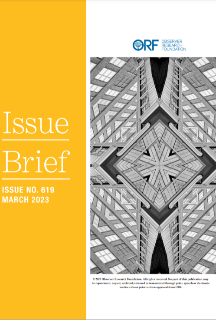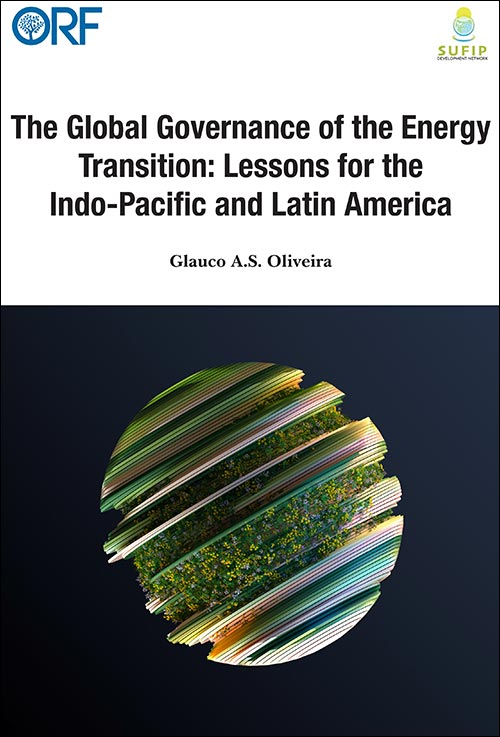Introduction
In early 2023, global attention appears to be fixed on Europe amid Russia’s continued invasion of Ukraine. Still, events in Asia—such as the G20 Summit in Indonesia and the ASEAN Summit in Cambodia (both in November 2022), and China’s constant military posturing against Taiwan—call for a renewed focus on this region. Asia has for long been a venue of intense competition between Washington and Beijing for geostrategic influence.[a] Currently, US-China rivalry is panning out over issues such as economic policies, territorial disputes in the South China Sea, and a jostling for strategic space in the tiny Pacific Islands such as Fiji and the Solomon Islands. The intensity of this rivalry is only slated to increase in the post-COVID-19 era.
A recent development in Asia that has not yet drawn much attention is the warming up of South Korea, a key US ally,[b] to China. Although South Korea has had a strong alliance with the US since the end of the Second World War, it has slowly drawn closer to China in the past three decades.[1] There has been a steadily growing strategic partnership between South Korea—a key cog in the US’s ‘hub and spokes’ model in Asia—and China, which has been involved in a bitter turf war with the US for supremacy in the region. The hub and spokes model, otherwise known as the San Francisco System,[2] is a network of alliances established by the US (the hub) and several countries in the Asia-Pacific—Japan, South Korea, Taiwan, Philippines, Thailand, Australia, and New Zealand (the spokes). This alliance network—through which the hub brought the ‘spokes’ under its security umbrella—has been critical in serving vital US security interests in the region. However, the rise of China in recent years has strained the model, with many of the spokes reeling under the ‘heat of the dragon’. The conventional understanding of international relations would suggest that South Korea should seek to balance against China to safeguard its interests, Seoul has instead chosen to bandwagon. While balancing refers to allying with other states against a common threat, bandwagoning refers to aligning with the source of the threat itself.
During a much-publicised tour to Asia in August 2022, former US House Speaker Nancy Pelosi was accorded an in-person meeting with Japanese Prime Minister Fumio Kishida in Tokyo. In contrast, South Korea was very lukewarm in receiving Pelosi in Seoul. It was reported that Pelosi was ‘politely’ refused a meeting with South Korean President Yoon Sook-yeol and that the two leaders only exchanged pleasantries over the phone. The official reason given to the US for Yoon’s inability to meet Pelosi in person was that he was on vacation (incidentally, he was present in Seoul the day of her visit).[3] Notably, the US House Speaker is the third highest office after that of the president and the vice-president. A few days after Pelosi’s visit, South Korea’s foreign minister, Park Jin, embarked on a three-day visit to China, where he met his counterpart Wang Yi in the eastern Chinese port city of Qingdao. Although the two incidents can be seen as part of normal diplomatic practices among sovereign nations, the symbolism is hard to ignore. Given the quickly developing geopolitics in the Indo-Pacific and the current Taiwan crisis,[c] such visits and calls by diplomats and high-profile political leaders are ever more closely scrutinised.
Given that this was the first high-level visit to China by a member of Yoon’s administration,[4] the timing of the meeting cannot be overlooked. While China fired ballistic missiles in Japan’s exclusive waters in retaliation to Pelosi’s visit,[5] it hosted and courted South Korea’s top diplomat and the two sides pledged to develop even closer relations.[6] Also, on the same day that it fired the missiles, China cancelled a foreign ministerial meeting with Japan[7] on the sidelines of the ASEAN Foreign Ministers’ Meeting in Cambodia in protest against the G7 statement on Taiwan.[d],[8]
Tensions between China and the US have only deepened as the crisis across the Taiwan Strait has intensified. Washington is keen to bolster its security relations with Seoul and Tokyo and present a united democratic front against a Beijing-Moscow axis, but South Korea’s bonhomie with China only complicates the matter. While China acknowledges South Korea’s close ties with the US, it has been urging Seoul to adopt a more ‘independent’ foreign policy, hoping to draw it to its side; on China’s foreign ministry website, Wang urged that China and South Korea should avoid being influenced by other forces[9] (the ‘other force’ almost certainly being the US). Indeed, the Chinese media celebrated Park’s visit as a snub to the US and interpreted it as Seoul siding with Beijing on the Taiwan issue in the context of Pelosi’s eyeball-raising visit to the region.[10] Notably, South Korea had also made a formal statement supporting the one-China principle at the onset of the ongoing Taiwan crisis.[11]
This brief analyses the reasons for South Korea’s closeness to China despite the threat it poses, and discusses the future of Seoul’s strategic posturing.
Understanding Seoul’s Proximity towards Beijing
What explains South Korea’s growing proximity to China, even at the cost of weakening the US’s ‘hub and spokes’ policy approach? It is expected that, like other US allies in the region, South Korea should also be fearful of a rapidly rising, authoritarian, and assertive China, a country with the military capabilities to threaten it. Still, there are several factors driving Seoul towards Beijing.
Economic benefits outweigh the military threat
China is South Korea’s largest trading partner, with the former having a strong economic leverage over the latter.[12] With the US backpedalling from the much-vaunted Trans-Pacific Partnership, South Korea became even more dependent on China. South Korea and China are both export-oriented economies and will not want any further supply-chain disruptions, especially in the aftermath of COVID-19 pandemic and while the global economy is already struggling due to the Russia-Ukraine conflict. In separate statements after their meeting in Qingdao, the South Korean and Chinese foreign ministers called for the development of relations based on “three decades of successful commercial ties”.[13] Given the deepening rivalry between Beijing and Washington, the reference to maintaining stable industry supply chains during the meeting may have been over fears that Chinese technology policy and US security concerns might split the world into separate markets that could slow down innovation, and thereby raise the costs of production.
Does this mean South Korea does not view China as a military threat? The realist school of thought says that a multipolar world is unstable and prone to major wars.[e] In such a case, small states like South Korea, when caught between two major powers, will look to safeguard their national interests, and will thus indulge in bandwagoning.[14] Bandwagoning happens when a weaker state decides that the cost of opposing a stronger power exceeds the benefits. As such, South Korea has accommodated China instead of balancing against it. It is bandwagoning with—and not against—China to share the economic spoils by conceding that the latter is the stronger adversary both militarily and economically. Compared to the military threat associated with China’s rise, South Korea sees substantially more economic opportunities due to it and it wants to gain from this. To be sure, even the US understands this and sees it as a major vulnerability in South Korea’s national security amid the rising Sino-American rivalry.[15]
The North Korean conundrum
The second important factor in understanding the growing strategic relationship between South Korea and China is the threat posed by North Korea. Unlike his predecessor, Yoon is hawkish on North Korea; during his presidential campaign, he said he would deal with North Korea sternly. Seoul is deeply concerned with Pyongyang’s efforts to expand its nuclear arsenal and its missile delivery systems. In an address to parliament in September 2022, North Korean leader Kim Jong-un said that the country will never give up nuclear weapons.[16] Criticising South Korea, Kim said the South Korea-US military exercises are “dangerous military actions that raises tensions”.[17]
South Korea shares a heavily militarised border with North Korea and will be the first to face the brunt of any North Korean military adventure. Indeed, the military threat North Korea poses to South Korea is worrisome as Seoul, its capital city, is within striking distance of rockets fired from North Korea. A Pentagon war scenario from 2017 suggests that South Korea would suffer 20,000 deaths per day at the beginning of a conventional war between the two sides, assuming North Korea does not use nuclear weapons.[18] In such a scenario, Seoul would best turn to Beijing, as the latter could use its influence over Pyongyang to prevent bloodshed in the Korean Peninsula. South Korea is also certainly wary of the US’s outreach to North Korea in the Trump era. Despite the change of government in the US, there remains a sense of disquiet in South Korea’s strategic circles over the US’s commitment to defend it in case of war with the North.
Seoul acknowledges Beijing’s special leverage over Pyongyang. As North Korea’s missile delivery systems and nuclear bombs grow in number and sophistication, South Korea would prefer China put that leverage to good use. During their meeting in Qingdao, the South Korean foreign minister requested his Chinese counterpart to urge Beijing to use its influence over Pyongyang to persuade the latter to return to talks on its nuclear weapons programme. Seoul realises that without Beijing’s cooperation, it is impossible to bring Pyongyang to the diplomatic table. The stalled six-party talks[f] remain the best option to deal with the North Korean nuclear threat, and Beijing is the driving force behind this format. Interestingly, the six-party talks are one of the few diplomatic tables where China and the US find themselves on the same side.
Japan and the Indo-Pacific
South Korea’s relations with Japan are going through a challenging period as both sides continue grappling over historical issues, such as that of the comfort women and forced labour during the Second World War.[19] Additionally, domestic politics in both countries, the rise of nationalism in Japan, and growing anti-Japanese sentiments in South Korea have heightened tensions. In 2019, South Korea announced its withdrawal from the critical three-nation intelligence sharing agreement with the US and Japan,[20] which had been a vital instrument for the two Asian countries in dealing with the North Korean nuclear threat since its inception in 2016. This shows the fragility of South Korea’s ties with Japan to the extent of compromising domestic and regional security.
South Korea has remained largely non-committal on the Indo-Pacific and has been sitting on the fence with ‘strategic ambiguity’ ostensibly to placate Chinese concerns.[21] China views the concept of the Indo-Pacific and the Quadrilateral Security Dialogue (Quad; comprising Australia, India, Japan, and the US) as an attempt to ‘gang up’ against it. China loathes the Quad and refers to the grouping as an “Asian NATO”[22]. Also, much to the US’s dismay, South Korea has avoided criticising China on human rights issues,[23] a key point of the global censure of China.
Challenges to the South Korea-China Relationship
Still, the South Korea-China bonhomie is not without challenge. The two countries have had their fair share of differences, and South Korea remains an ally of the US, the global power that China hopes to dethrone in the near future. Bilateral relations between South Korea and China took a downward turn in 2017 when the former installed the Terminal High Altitude Area Defense (THAAD) anti-ballistic missile system procured from the US apparently to shield Seoul from North Korean nuclear missiles. China retaliated by placing embargos on South Korean businesses. In 2022, Yoon called for an additional deployment of THAAD batteries during his presidential campaign. One of Beijing’s primary preconditions to maintaining maintaining stable relations with Seoul is that it does not install any new THAAD batteries[g] as it believes the system’s powerful radar can probe deep into its territory.[24] Indeed, China is of the view that it is the real target of the THAAD system.[25]
Just as South Korea needs China to bring North Korea back to the talking table, it needs the US military and its hardware to thwart the North Korean threat. As such, the Yoon administration is keen to bolster security ties with the US and Tokyo and move away from his predecessor’s policy of ‘strategic ambiguity’. Yoon held summit meetings with US President Joe Biden in Seoul in May 2022, mere days after assuming power as South Korea’s president, and with Japanese Prime Minister Fumio Kishida in Tokyo in July. In his speech to the nation on 15 August, celebrated in South Korea as ‘Liberation Day’ and in Japan as ‘Memorial Day for the End of the War’,[h] Yoon emphasised the importance of cultivating future-oriented ties with Japan to overcome the burden of historical issues. Later that month, the US and South Korean combined forces held their first live-fire exercises since the unit’s formation in 2015.[26] China would be wary of the Yoon administration’s already growing security relationship with the US and it would be keen that Seoul continues with its policy of ‘strategic ambiguity’. Given the current tensions across the Taiwan Strait, Beijing would greatly value a Korean Peninsula where both North and South Korea are under its strategic ambit.
Conclusion
In the future, South Korea is certain to seek to balance its relations with China and the US, even as it attempts to mend ties with Japan. Both the US and Japan are keen to avoid South Korea from drifting further towards the Chinese camp and want the Yoon administration to commit on the Indo-Pacific front. Although South Korea will look to re-augment its ties with the US, it realises that it can ill-afford a confrontational attitude towards China and must remain in its good books. South Korea appears to have concluded that the economic benefits accruing from China far outweigh the security challenges posed by it, at least for now. Also, South Korean security planners do not see any future Chinese motive of attacking or militarising the Korean Peninsula,[27] which means that South Korea does not view itself as a victim of Chinese belligerence.
At the same time, South Korea will seek to create a buffer against China as a surety, and in that context, it will look to beef up its security relationship with the US and Japan. It may well do so citing the North Korean threat, which even China cannot deny. Wherever necessary, South Korea will side with the US and the democratic world, as it did by placing economic sanctions against Russia as soon as it invaded Ukraine, despite Moscow’s closeness to Beijing.
South Korea is entrenching itself to play the long game in one of the world’s most volatile regions. A nuclear North Korea is one area where the interests of the US, China, Japan, and South Korea align, and Seoul will seek greater cooperation with all three on this front.
Endnotes
[a] ‘Excessive’ Chinese claims in the South China Sea as against the US-Japan-led concept of ‘Free and Open Indo-Pacific’ is a case in point.
[b] South Korea is among 19 countries designated as a ‘Major non-NATO Ally’ by the US government. This status provides certain benefits in the areas of security and defence cooperation.
[c] In response to Pelosi’s Asia visit, the Chinese military began exercises on 3 August 2022, which led to what is now being referred to as the Fourth Taiwan Strait Crisis.
[d] The G7 members reiterated their commitment on maintaining peace and stability across the Taiwan Strait and urged all parties to exercise calm and restraint.
[e] Neorealists argue that the shifting from unipolarity to multipolarity could affect the stability of the world order and is prone to wars. They argue that history has shown that multipolarity is more war-prone and unstable than unipolarity or bipolarity.
[f] The last round was held in 2019.
[g] This is part of the so-called ‘Three Nos’ policy between China and South Korea—no new THAAD batteries in South Korea, no US-Japan-South Korea trilateral missile defence system, and no US-Japan-South Korea security alliance.
[h] To commemorate the liberation of Korea from Japanese rule in 1945.
[1] D. C. Kang, “Between Balancing and Bandwagoning: South Korea’s response to China,” Journal of East Asian Studies, Vol. 9, No. 1.
[2] Leszek Buszynski, “The San Francisco System: Contemporary Meaning and Challenges,” Asian Perspective, Vol. 35, No. 3 (July-Sept. 2011), pp. 315-335.
[3] Mitch Sin, “South Koreans question President Yoon’s decision to skip meeting with Pelosi,” The Diplomat, August 4, 2022.
[4] Shin Hyonhee, “South Korea-China ministers meet,” Japan Times, August 10, 2022.
[5] “Chinese-fired ballistic missiles fall into Japan’s EEZ: Gov’t,” Kyodo News, August 5, 2022.
[6] “Top Chinese and Korean Diplomats pledge closer ties,” The Mainichi, August 10, 2022.
[7] “China cancels G7 meeting with Japan after Taiwan Statement,” Reuters, August 4, 2022.
[8] US Department of State, “G7 Foreign Ministers’ Statement on Preserving Peace and Stability Across the Taiwan Strait”, August 3, 2022,
[9] “Chinese FM urges more independent, mature bilateral ties,” Global Times, August 9, 2022.
[10] Hyonhee Shin, “In a first visit to China, South Korean foreign minister seeks to reassure Beijing over US ties,” Reuters, August 8, 2022.
[11] Jo He-rim, “Foreign minister to make first visit to China next week,” The Korea Herald, August 5, 2022.
[12] Steven Danny, “South Korea’s economic dependence on China,” The Diplomat, September 4, 2015.
[13] “Top Chinese and Korean Diplomats pledge closer ties”
[14] Thomas S. Mowle and David H. Sacko, Balancing and Bandwagoning in a Unipolar System (Palgrave Macmillan, 2007), chap. 4, pp. 65-86
[15] Andy Hong, “The Limits of China’s Economic Leverage over South Korea,” The Diplomat, June 20, 2022.
[16] Kim Tong-Hyung, “N. Korea says it will never give up nukes to counter US,” Associated Press, September 9, 2022.
[17] Mitch Shin, “North Korea warns of ‘consequences’ for South Korea-US joint military exercises,” The Diplomat, November 1, 2022.
[18] Jeff Daniels, “Pentagon scenario of a new Korean war estimates 20,000 deaths daily in South Korea, retired US general says,” CNBC, September 25, 2017.
[19] Amlan Dutta, “Comfort Women Issue and its impact on Japan-South Korea relations,” ORF, August 6, 2022.
[20] Dutta, “Comfort Women Issue and its impact on Japan-South Korea relations”
[21] Titli Basu, “Scaling up Seoul’s game in the Indo-Pacific,” Manohar Parikkar Defense Studies and Analyses, March 14, 2022.
[22] “US trying to create Asian NATO with blocs to ‘suppress’ China: FM Wang Yi,” Business Standard, March 7, 2022.
[23] Andrew Yoo, “Can South Korea chart a path between the US and China in the Indo-Pacific?” Brookings, August 15, 2022.
[24] “China, Russia share opposition to US-THAAD in South Korea: Xi,” Reuters, July 3, 2017.
[25] Adam Taylor, “Why China is so mad about THAAD, a missile defense system aimed at deterring North Korea,” The Washington Post, March 7, 2017.
[26] Brad Landon et al., “US and South Korean forces hold first live-fire exercises since new unit formed,” CNN, August 21, 2022.
[27] Kang, “Between Balancing and Bandwagoning: South Korea’s response to China”
The views expressed above belong to the author(s). ORF research and analyses now available on Telegram! Click here to access our curated content — blogs, longforms and interviews.

 PDF Download
PDF Download



 PREV
PREV


